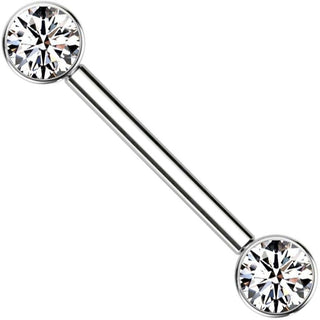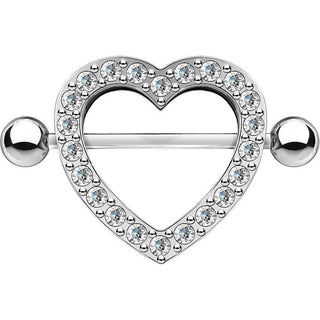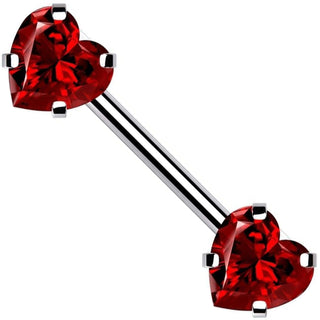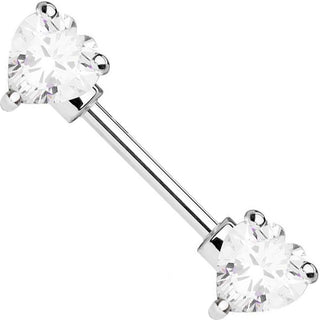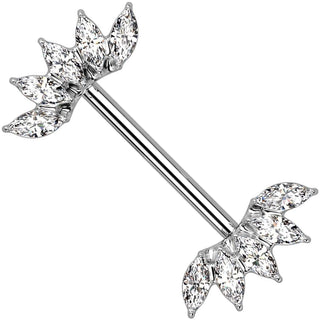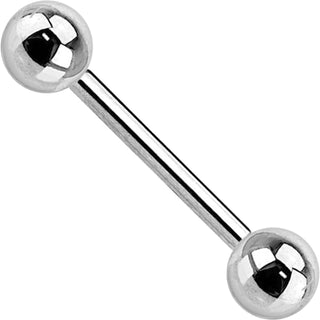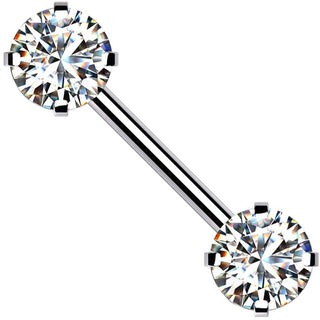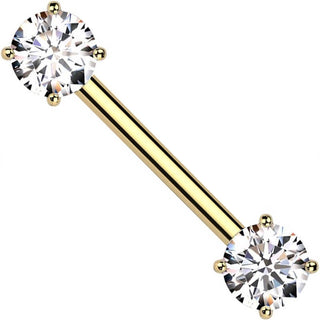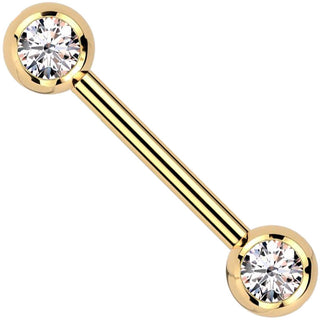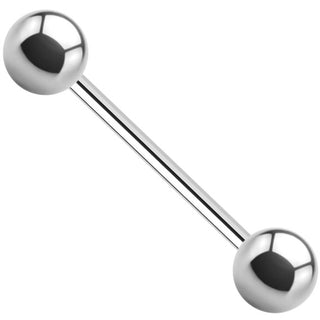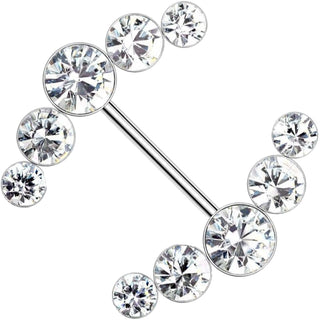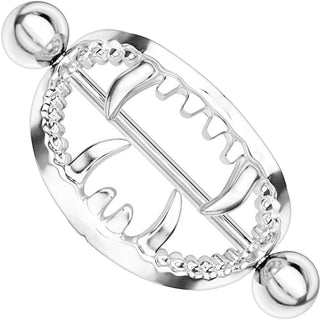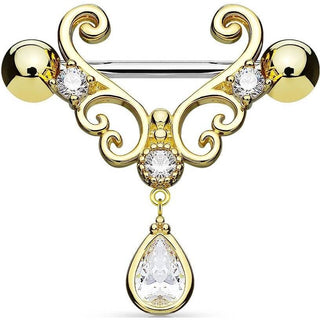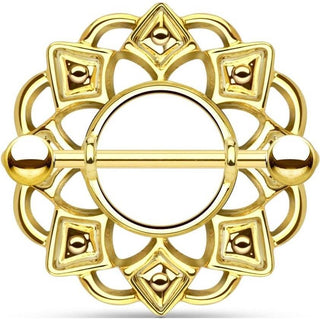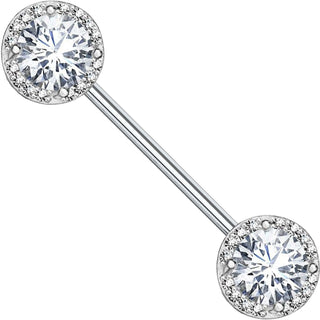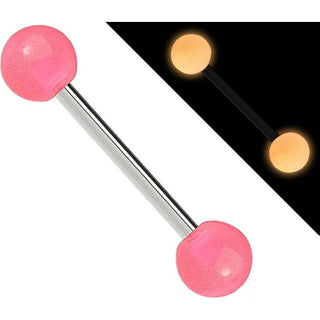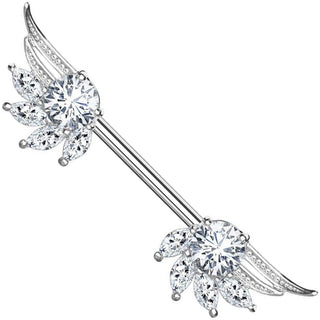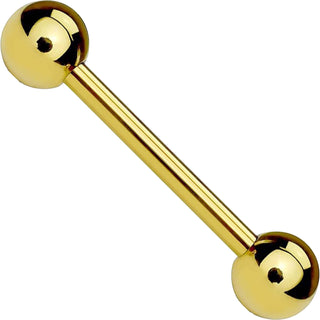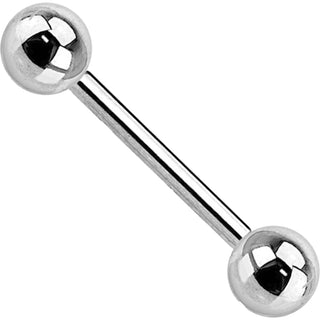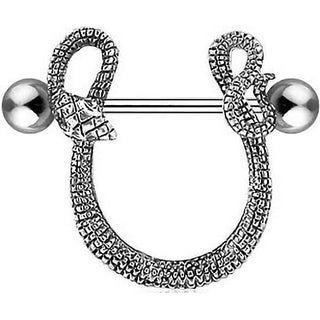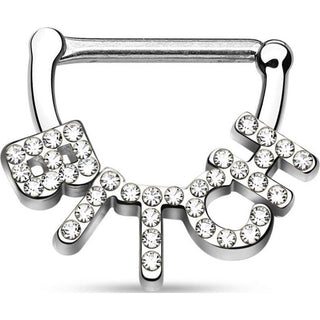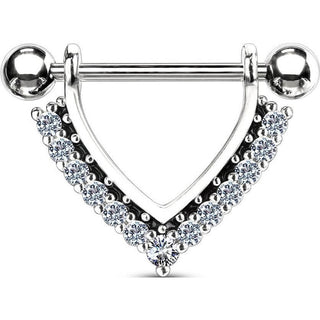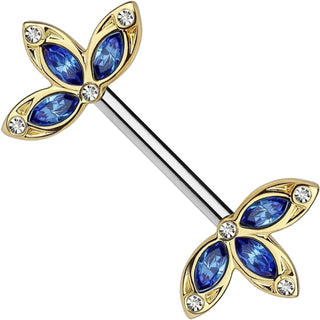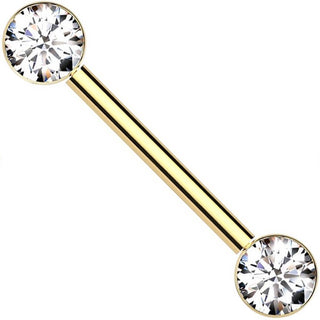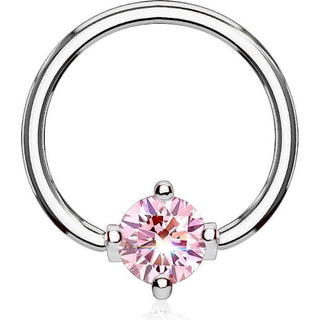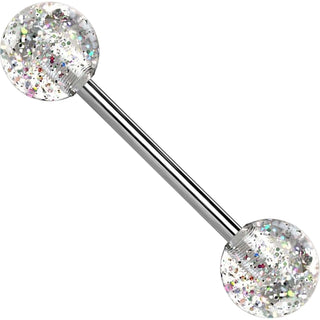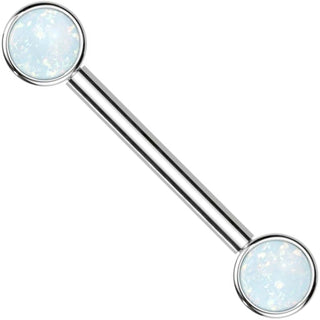Nipple Piercing
Discover our wide selection of over 500 nipple piercings! Made from top-quality materials like Titanium and 316L Surgical Steel, all at great prices. Enjoy excellent customer service at our shop.
Nippelpiercing
Den Nippelpiercing ass eng ganz populär a modesch Zort vu Piercings déi net nëmmen schéin ausgesäit, mee och dem Droer en erotesche Kick gëtt. Mat dësem Intimpiercing ginn ee oder béid Nippel gestach a mat schéine Schmuck dekoréiert.
De Broscht-Piercing kann vu Fraen a Männer gedroe ginn. D'Broscht kann mat ville verschiddene Zorte vu Piercing-Schmuck dekoréiert ginn. Zum Beispill ginn Piercingrank, Hufeisen-Piercing, Barbell Piercing oder speziell Nippelschëlter hei benotzt.
An eisem Shop fannt Dir eng grouss Auswiel u schéine Nippelschmuck an eenzegaartege Motiver a Motiver wéi Déieren, Stären oder Blummen. An dësem Guide fannt Dir all déi wichteg Informatiounen iwwer Nippelpiercing, vum Piercing an dem richtege Schmuck bis hin zu de Risiken.
Typen vun Nippelpiercingen
Nippelpiercingen kënnen vertikal oder horizontal duerch den Nippel gestach ginn. De horizontalen Nippelpiercing ass déi populär an am meeschte verbreet Variant. Manner dacks kann e Nippelpiercing och diagonal plazéiert ginn. Ob nëmmen ee oder béid Nippel gestach ginn, ass komplett un der Virléift vum Droer. D'Plazéierung an d'Auswiel vun der Säit ass och eng Saach vun der Wiel.
D'Nippelpiercing-Varianten kënnen och op all Manéier kombinéiert ginn. Duerch d'Stiechen vun zwou horizontalen oder vertikalen Piercingen op engem Nippel gëtt e duebelen Nippelpiercing erstallt. Duerch d'Kombinatioun vun engem vertikalen an engem horizontalen Piercing op engem Nippel kritt den Nippel e eenzegaartege Look a Kräizform.
Piercing Schmuck fir d'Broscht
D'Nippel kënne mat ville verschiddene Zorte vu Piercing Schmuck verschléisst ginn. Dëst beinhalt Réng, Hufeisen, Nippelschëlter a souwuel riicht wéi och gebuënn Barbells. Schmuckvarianten mat Pendants bidden e spezielle Look. E charmante Look kann mat Hëllef vu verbindende Ketten erstallt ginn, déi um Nippelschmuck befestegt ginn. Eise Shop huet eng grouss Auswiel u Nippelschmuck fir all Stil.
Einfach Chirurgesche Stol Piercing an Titan Barbell Piercing kreéieren e einfachen a diskreten Look. Déi einfach Barbells kënnen och mat faarwege oder Kristall-besaten Perlen opgewäert ginn. Barbells am Fan-Design a Barbells mat Pendants kréien d'Nippel an ginn dem Droer méi Selbstvertrauen. D'Pendants kënnen a ville eenzegaartege Motiver wéi Masken, Handbäll, Ranken oder Schlaangen geformt ginn.
Nippelréng ginn den Nippel e distincten an interessanten Look. Béibar Piercingring, CBR, Hufeisen-Piercing, Segmentrank a Segment Segment Clicker kënne als Nippelréng benotzt ginn. Einfach Réng bidden e klassesch Look, wärend méi ongewéinlech Rank-Designen kënne benotzt ginn fir individuell Akzenter ze kreéieren.
Nippelschëlter kréien d'Nippel geschéckt a ginn der Broscht e eenzegaartege Look. Si sinn a ville verschiddene an interessanten Motiver wéi Turbinen, Stären, Blummen, Spikes oder Sonn verfügbar. Et gëtt souwuel einfach Metall-Nippelschëlter wéi och opwänneg dekoréiert Nippelschëlter mat Zirkonien.
Schmuck fir d'Nippel kann aus ville verschiddene Materialien gemaach ginn. Déi besonnesch héichqualitativ Materialien Titan a 14 Karat Gold bidden vill Virdeeler. Éischt a virun allem sinn si allergesch a luxuriéis. Chirurgesche Stol Schmuck huet och vill Virdeeler, déi d'Material ganz populär maachen. Dat rostfräit an haltbar Metall ass am Verglach méi bëlleg an awer vun héijer Qualitéit.
Fake Broschtwëtzréng erlaabt Iech de Look op Ärer eegener Fräizäit ze probéieren, ier Dir en Nippelpiercing kritt. Déi verstellbar Nippelklammeren sinn an eisem Shop a ville Motiver an och mat schéine Pendants verfügbar. Fir Leit, déi besonnesch schmerzempfindlech sinn, sinn Fake Piercing fir Nippel déi bescht Léisung, fir dëse trendy Piercing ouni schwéiere Schmerz ze genéissen.
Nippelpiercing
D'Piercing vun engem Nippelpiercing ass ähnlech wéi aner Piercing-Typen. D'Géigend, déi gestach soll ginn, gëtt grëndlech gebotzt, desinfizéiert a d'Stéckpunkten markéiert. Nodeems d'Plaz bestëmmt ass, gräift de Piercer den Nippel mat enger Zangen. Den Nippel gëtt dann mat enger huel a steriler Nadel gestach an den éischte Schmuck agefouert. An de meeschte Fäll ass dëse Prozess bannent e puer Sekonnen ofgeschloss.
Déi meescht Piercer benotzen Barbell Piercing als éischte Schmuck fir eng séier Heilung. D'Stéckdéckt vun der Hantel ass ongeféier 1,6 mm - 2 mm. D'Längt vun der Hantel gëtt individuell fir all Piercer bestëmmt. Et sollt ongeféier 3 mm vun der Hantel op béide Säite vum Piercingkanal erausstiechen. Dës méi laang Stéckgréisst bitt Plaz fir d'Schwellung vum Nippel.
Am Fong kann jidderee en Nippelpiercing kréien. D'Anatomie vun den Nippel ass fir jiddereen anescht, mä bal all Nippel ass gëeegent fir dës Zort Piercing. E Nippelpiercing kann och während enger Broschtvergréisserung oder -reduktioun gestach ginn. Wéi och ëmmer, et sollt genuch Zäit tëscht den zwou Prozeduren sinn, fir datt de Kierper sech erhale kann an richteg heele kann.
Leider, well den Nippel e zimlech empfindlechen Deel vum Kierper ass, ass de Schmerz fir déi meescht Leit méi staark. Fir de Schmerz vum Stéck méi erträglich ze maachen, kann d'Géigend och virdru betäubt ginn.
D'Käschte vun engem Nippelpiercing hänke vu verschiddene Faktoren wéi der Regioun an dem Studio of. Am Allgemengen läit de Präis fir e Nippelpiercing tëscht ongeféier 40€ - 70€.
Heelung an déi richteg Pfleeg
D'Dauer, déi et dauert, bis e Nippelpiercing geheelt ass, hänkt normalerweis vun Ärer eegener Anatomie of. Kleng Nippel mat enger Breet vu manner wéi 10 mm sinn no ongeféier 3 - 4 Méint komplett geheelt. Nippel, déi méi grouss wéi 10 mm sinn, daueren méi laang fir ze heelen, ongeféier 6 - 9 Méint. Eréischt no der kompletter Heilung däerf den éischte Schmuck ersat ginn.
An der éischter Woch no der Stéck vun den Nippel kann d'frësch Wonn mat engem Plaster bedeckt ginn, well d'Nippel erëm bléde kënnen. D'Benotzung vu sterile Kompressen kann och hei hëllefen, besonnesch mat der Ausscheedung vu Kierperflëssegkeeten.
D'Nippel sollten fir 2 Wochen no der Stéck zweemol am Dag gebotzt an desinfizéiert ginn. D'Hänn sollten virun all Kontakt mam Piercing desinfizéiert ginn. Beim Duschen sollten mëll a léiwer PH-neutral Mëttele benotzt ginn, fir ze verhënneren, datt irritéierend Substanzen an de Piercingkanal kommen. No der Dusche kënnen déi gedréchent Krustë virsiichteg ewechgeholl ginn an de frësche Piercing kann sanft mat engem lintfräie Stoff gedippt ginn. Duerno gëtt d'Botzen mat spezielle Piercing-Fleegprodukter recommandéiert.
Besonnesch bei engem Nippelpiercing sollt grouss Suergfalt beim Un- an Ausdoen vun Kleeder getraff ginn. Déi baussenzeg Kleeder sollten sanft a lues un- an ausgezu ginn, well ze rau Prozedur dozou féiere kann, datt de Nippelschmuck hänke bleift. Am schlëmmste Fall kann de Broscht-Piercing souguer aus dem Nippel erausgerappt ginn. Dofir sollt ee ëmmer vill Zäit huelen a virsiichteg beim Kleeder sinn.
Frae sollten einfach, enk passend BHs aus engem atmungsaktive Stoff wéi Koteng während der Heilungsphas droen. Sports-BHs si besonnesch gëeegent dofir. BHs mat Spëtz an Dekoratiounen wéi Schleifen oder Rüschen sollten fir de Moment vermeide ginn. De Broscht Schmuck kann liicht hänke bleiwen a mat all Bewegung onbequem reiwen oder erausgerappt ginn. Fir Männer ass en enk passenden Top genuch, fir de Nippelschmuck op der Plaz ze halen.
Dir sollt Sport fir op d'mannst déi éischt 14 Deeg no der Stéck vermeiden, fir Schweessen an onnéideg Reiwung während kierperlecher Ustrengung ze vermeiden. Wéi och ëmmer, och no den éischte zwou Wochen an während dem komplette Heilungsprozess, kann de Nippelpiercing als lästeg beim Sport empfonnt ginn. An dësem Fall kann d'Bedeckung vum Schmuck mat engem Plaster d'Reiwung a méiglech Haken un der Kleedung verhënneren.
Spillen mat den Nippel sollt während der ganzer Heilungsphas vermeide ginn. Solange de Kanal net komplett geheelt ass, ass de Nippelpiercing méi ufälleg fir Rëss. Rëss favoriséieren am Géigendeel d'Verbreedung vu Keimen an doduerch Entzündungen.
Schwanger Frae sollten hire Nippelschmuck spéitstens vum sechste Mount ewechhuelen, well d'Broscht méi grouss a ganz empfindlech während der Schwangerschaft gëtt. Fréi Entfernung vu Schmuck gëtt vu ville schwangere Frae wéinst der erhéiter Empfindlechkeet bevorzugt. Nippelschmuck sollt och net während dem Stillen gedroe ginn, fir datt de Puppelchen net dem Risiko vu Schlécke ausgesat gëtt. No der Stillzäit kann de Schmuck no ongeféier 2 - 3 Méint erëm agefouert ginn.
Risiken vum Nippelpiercing
Nippelpiercing, wéi all aner Zort Piercing, ass mat Risiken assoziéiert. An dësem Sektioun fannt Dir eraus, wéi eng Risiken méiglech sinn a wéi Dir se reduzéiere kënnt.
Wéinst der méi laanger Heilungsphas ass de Risiko vun Infektioun bei engem Nippelpiercing erhéicht. Dofir ass gewëssenhaft a reegelméisseg Fleeg fir eng problemfräi Heilung entscheedend. Symptomer vun Infektioun enthalen gielzeg oder grénglech Eeter, schwéier Rötung a Schwellung vum Intimpiercing fir Nippel, a persistent, schwéiere Schmerz. Bei engem infizéierte Piercing kann d'Haut ronderëm de Piercing och waarm sinn. Wann dës Zeechen mam Piercing optrieden, sollt de Piercer direkt konsultéiert ginn.
Schwellung vun den Nippel ass normal direkt nom Piercing a stellt nëmme e Risiko, wann den éischte gewielte Schmuck ze kleng ass. An dësem Fall sollt de Kierperschmuck vum Piercer direkt duerch e méi laange ersat ginn.
D'Piercing vun den Nippel kann Konsequenze fir spéider Stillen hunn. D'Mammaräiwen kënne vum Piercing blockéiert ginn an de Mëllechfluss kann doduerch verlangsamen. D'Mammaräiwen kënnen och beschiedegt ginn, wann de Piercing falsch gemaach gëtt. Dëse Risiko kann duerch e professionelle Piercer mat vill Erfahrung miniméiert ginn.
Frae mat Nippelpiercingen kënnen méi empfindlech Nippel während der Menstruatioun hunn. Och Piercingen, déi scho laang geheelt sinn, kënnen dann schwellen oder Péng verursaachen. Dëst Phänomen ass unangenehm, mä d'Symptomer verbesseren sech normalerweis no e puer Méint. Wat méi laang Dir de Piercing hutt, wat et manner schmerzhaft während Ärer Period ass.
E Nippelpiercing kann wéi all aner Piercing eraus wuessen. De Piercing gëtt vum Kierper verworf an ëmmer méi vum Schmuck gëtt sichtbar. D'Distanz tëscht de Kugelen an dem Piercingloch gëtt méi grouss. D'Piercingloch kann sech vergréisseren an d'Piercingplaz gëtt dréchen, rout a empfindlech. An dësem Fall sollt och de Piercer konsultéiert ginn. Wann néideg, kann dëse Prozess gestoppt ginn duerch den Austausch vum Schmuck. Wann dat net hëlleft, muss de Kierperschmuck ewechgeholl ginn, fir datt keng Narben entstinn.


